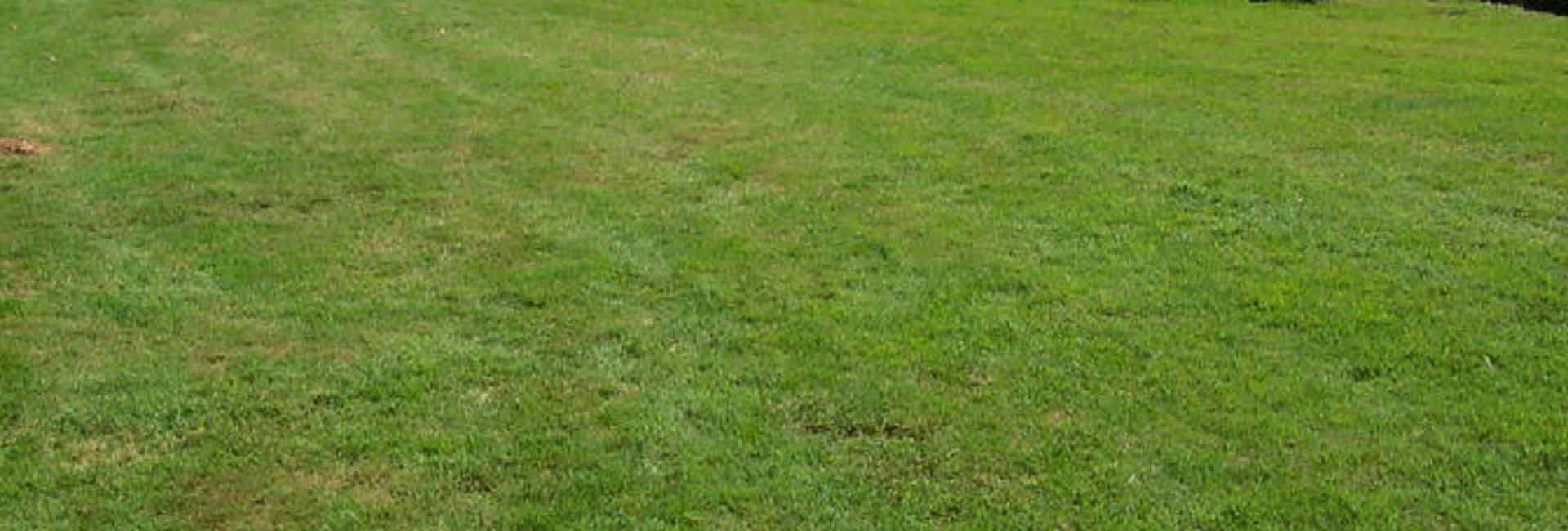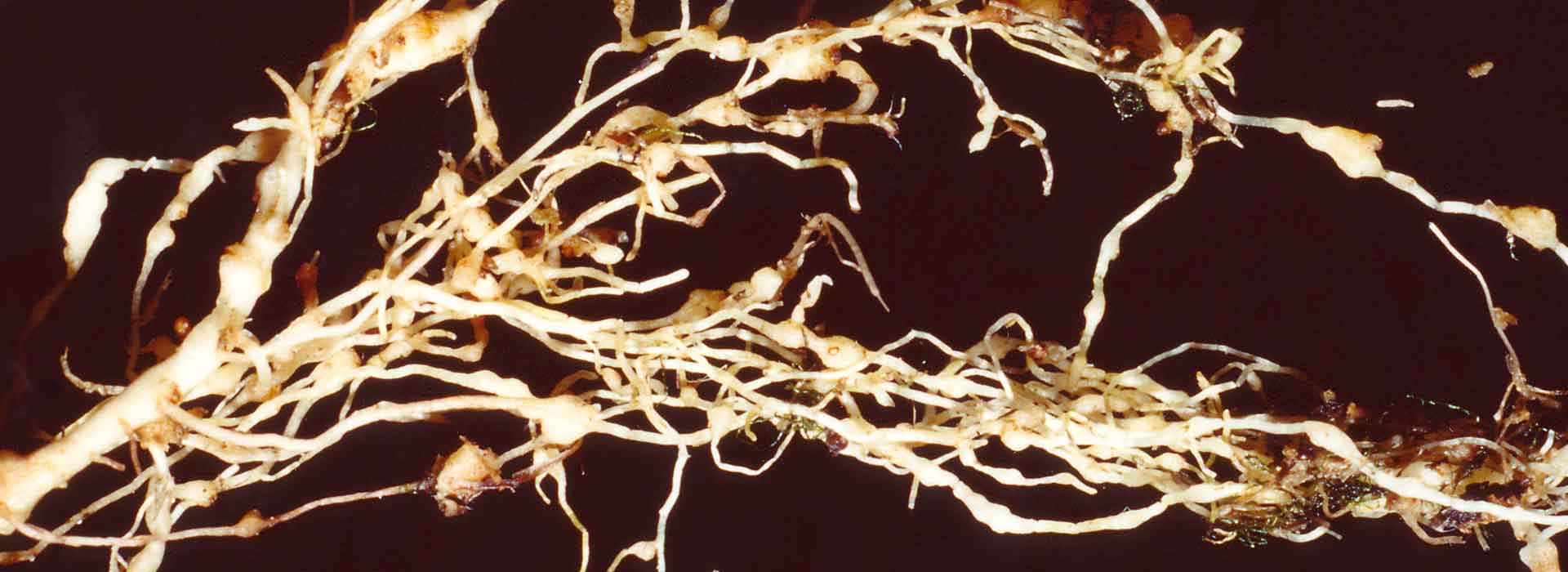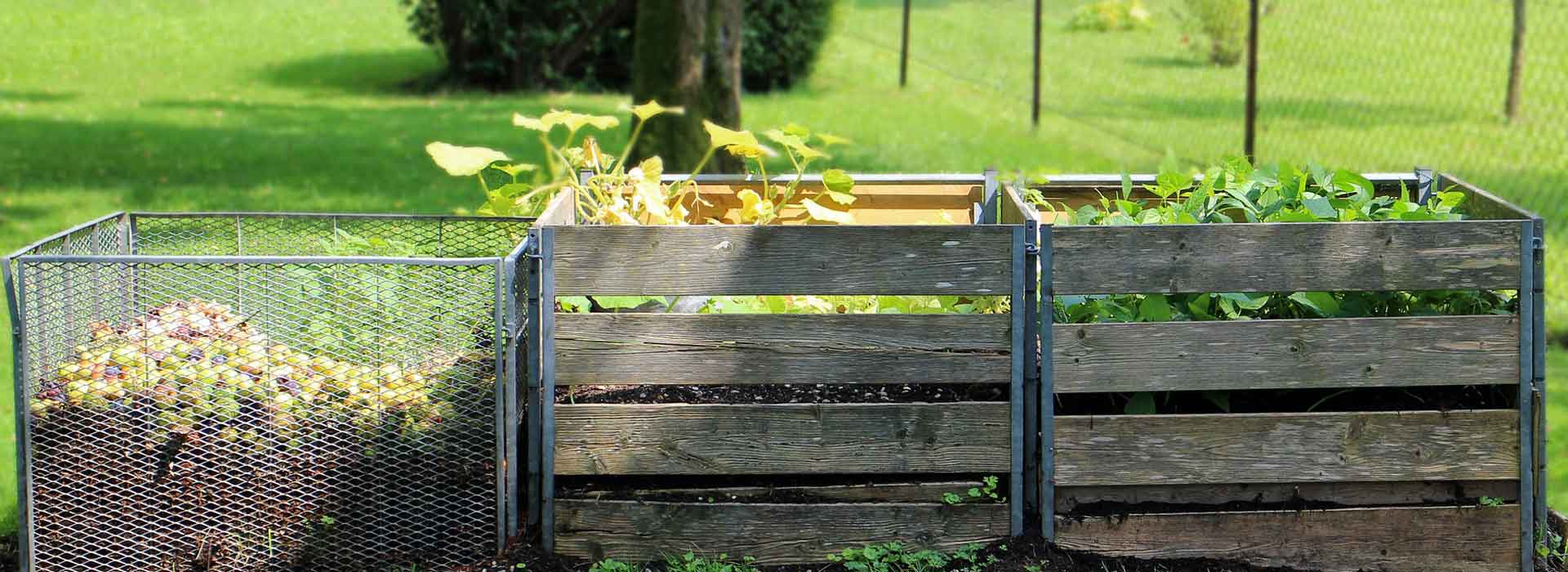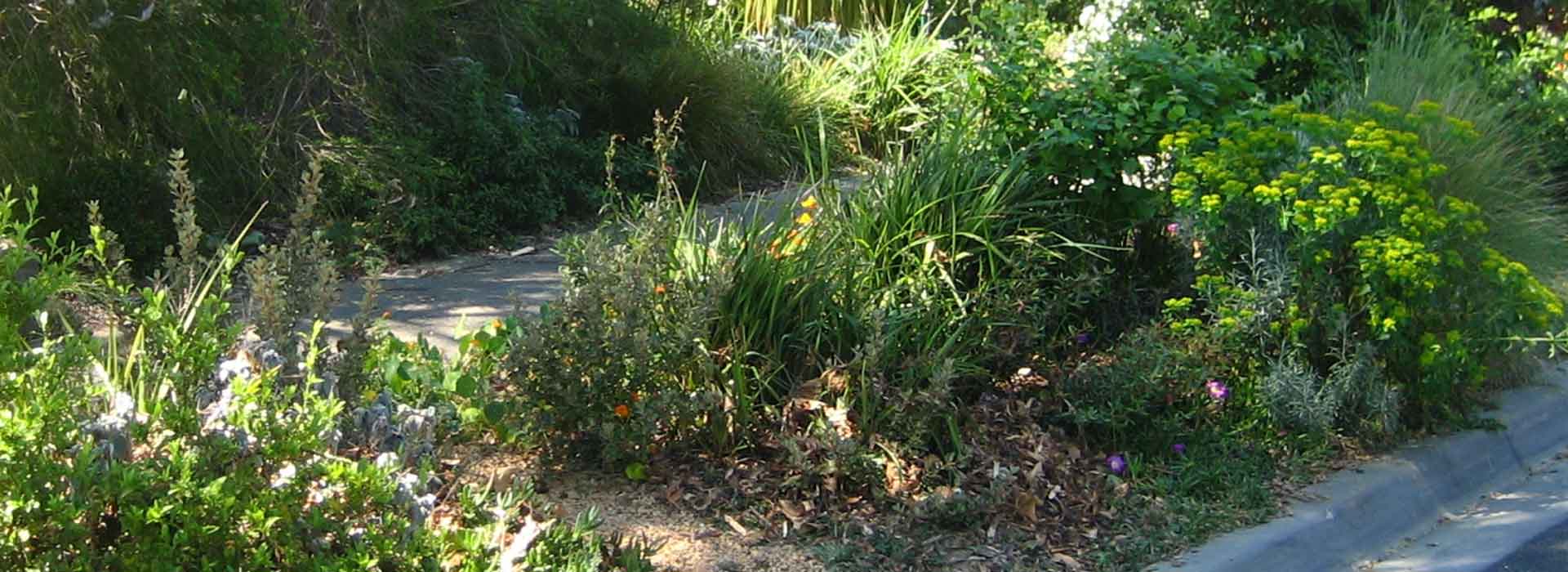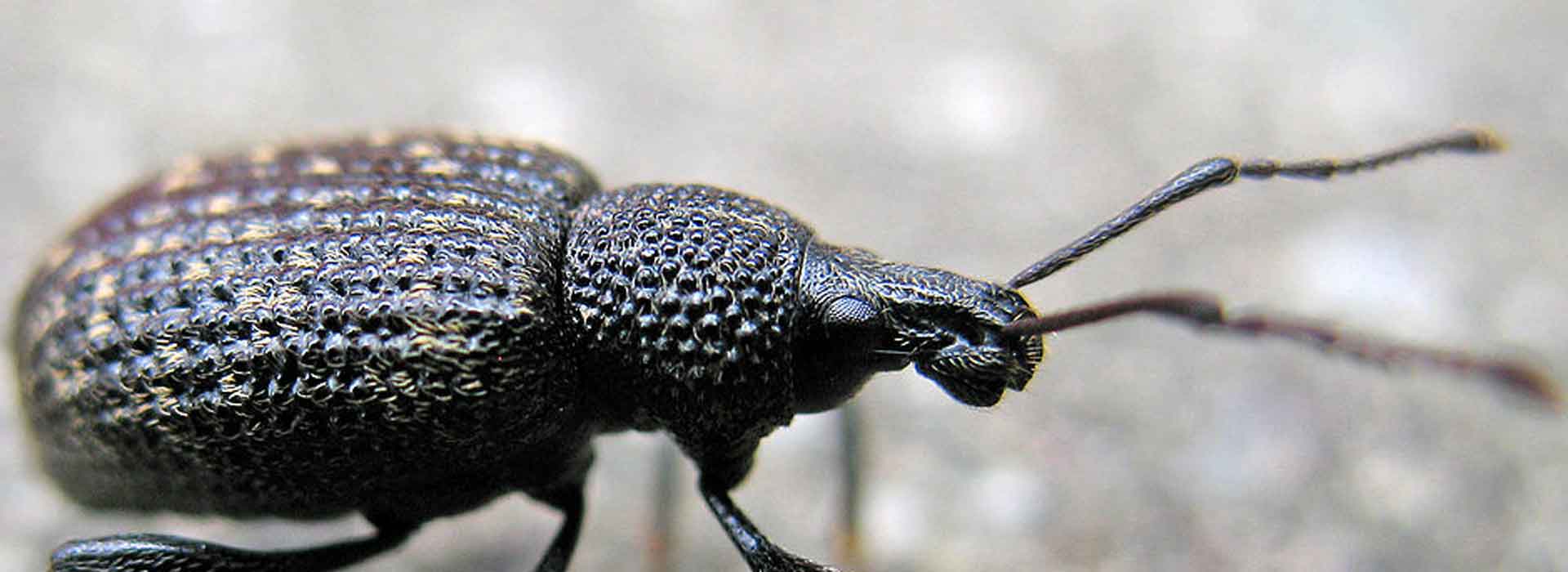Parsley
Parsley – okay, it can be a bit ubiquitous, turning up as a garnish on all manner of dishes, from salads to steaks and everything in between. But don’t write it off; parsley is amazingly good for you and is an excellent cure for the dreaded ‘onion breath’. Plus, it’s dead easy to grow, needs very little water, and will fancy up your next dinner party!
Position, Position, Position!
Position depends on the variety of parsley you choose to grow - flat leaved ‘Italian’ parsley loves a hot spot in full sun, whereas the ‘Curly’ parsley will do best in a part sun position, where it receives about four hours of sun a day.
Talking Dirty
Parsley loves nothing more than a rich soil, chock full of compost. If growing in pots, which parsley adores, choose an organic potting mix. Both types of parsley do best with a neutral pH, so aim for about pH 7.
Feed Me!
Like many leafy, green vegies and herbs, parsley will respond really well to regular feeding. Use a liquid seaweed feed at planting time and then continue weekly until plants are about 20-25cm tall.
What About The Water?
Ever heard the term ‘wet feet’? Well, this applies to parsley! They like it damp and will run to seed rapidly if left to dry out. For a prolonged lifespan and healthier plants, water every second morning (but only if the soil is not damp!).
Pests and the Rest
Parsley suffers from very few issues but watch out for snails and slugs. If left to bolt to seed, you may find parsley throughout your Yummy Yard in years to come!
Are we there yet?
There is no specific time limit here, but, as a rule, wait until two rows of nice, strong stalks have formed and harvest, as required, from the outside. Parsley is a biennial, so, in the right spot, it should continue to grow and provide much parsley for a couple of years!
Hot tip
Parsley are said to make excellent companion plants for both tomatoes and asparagus and apparently improve the flavour of both significantly.
Good friends: Asparagus, corn and tomatoes.
Bad friends: Lettuce.
Basil
Ocimum sp.
Basil - surely one of the best known herbs in the world, and with good reason! It's tasty, it's attractive and it's dead easy to grow. With over 100 different species to choose from, Basil is never faulty! So, let's get growing!
The most common type of basil grown in the home patch is sweet basil (Ocimum basilicum), so let's focus on that one. Bear in mind that most basil species enjoy similar growing conditions, so these handy hints will apply pretty much across the board!
Planting Schedule
Warm Areas: September
Temperate Areas: September
Cool to Cold Areas: October (once frost risk has passed)
Position, Position, Position!
Like me, Basil doesn't really like the cold, which is good news for people in warm and temperate areas, but can lead to a bit of strife in colder regions. Sweet basil is what we learned horticulturists refer to as a "summer growing annual" meaning that, in theory, basil will die back once the cold hits every year. But, for those of us lucky enough to live in frost free tropical areas, a well tended basil plant can kick on for years!
So, where to position your basil plant(s) in your Yummy Yard? My hot tip would be somewhere... well... hot! Basil loves full sun, but in really warm areas, they don't mind part shade. In the cooler climes, ensure your basil has at least four hours of sun each day.
Talking Dirty
Sweet Basil loves a beaut, rich soil, full of organic matter, but not chook poo! Try enriching your soil with chook poo free compost... your basil will thank you for it! The more fertile your soil is, the better flavour and performance your basil will have. And, as with all our Yummy Yardies, mulch with pea straw or similar.
Feed Me!
What I am about to say flies in the face of normal, sustainable horticultural practice, but, like me, basil needs food, and lots of it! Sweet basil is what we call a gross feeder (a bit like some of my work colleagues) and will eat anything it is given. Liquid seaweed, worm wee or liquid manure is the best, and this should be applied fairly frequently through the growing season, for fragrant, healthy, tasty basil. And remember, the more you pick, the more you need to feed!
What about the Water?
Let's talk watering, 'cos basil likes it fairly damp. Now, before you go nuts on the end of the hose, use your soil moisture sensor! What do you mean you don't have one? Your pointer finger is the greatest soil moisture sensor in the world... and most of us have two of those. Stick your chosen finger in the soil, and remove. Is it damp, and is there dirt stuck to your finger? If yes, it doesn't need a water. If no, read on! Water in the morning, to avoid water on the foliage as the temperature cools down. Never ever ever water your basil with greywater!
Are We There Yet?
There is no set time to eat basil... essentially any time you feel like it is great. And remember, the more you eat, the better the plant will be, especially if you give it a feed after using.
Pests and the Rest
Sweet Basil does have a few pest and disease issues, but one thing is guaranteed... if you plant it, they will come (they being snails and caterpillars).
Hot Tip
Now here's my red hot tip for growing basil - pick often! Oft picked basil will not go leggy and doesn't set seed too early, leaving you loving your basil for longer. Oh, and the pretty purple/white flowers should be removed to... if you want luscious leaves and fragrant flowers for longer.
Eat me! - (BLT) Basil Loves Tomato
Basil and Tomato Salad
This is the ultimate basil and tomato salad.
Thinly slice freshly picked home grown tomatoes and lay them on a serving plate. Thinly slice a red onion and scatter on top of tomatoes. Season by shaking salt and ground black pepper on top.
Pick your home grown basil, stems and all.
Pick the larger leaves off the stems and set side.
Place the smaller leaves and the stems into a saucepan with ½ Cup balsamic vinegar, ½ Cup olive oil and 1 Tb brown sugar.
Bring this salad dressing to boil, then simmer gently until it is reduced by half.
Strain the dressing to remove the basil leaves and stems.
Drizzle dressing over the salad, then garnish with the larger basil leaves you set aside.
Also try:
Adding bocconcini or other favourite soft cheese on top.
Placing the salad on crusty bread and pouring the dressing on top for a different type of bruschetta.
Basil pic © Elaine Shallue (SGA)
Guerrilla Gardening
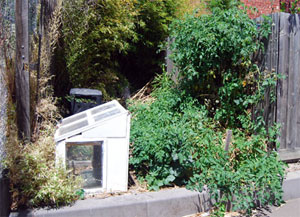 Bombs, guns, pitchforks, masks, false identities and missions under the cover of darkness... this ain't a warzone, or a bad Tom Cruise film, this is Guerrilla Gardening, and it's popularity is growing, both throughout Australia and the rest of the world! This is hardcore horticulture, full-on flora, seed sowing at its sexiest, plantings with purpose... and it's darned important. But what is it, why does it exist, who's involved, and, most importantly, were any Guerrillas harmed in the making of this story?
Bombs, guns, pitchforks, masks, false identities and missions under the cover of darkness... this ain't a warzone, or a bad Tom Cruise film, this is Guerrilla Gardening, and it's popularity is growing, both throughout Australia and the rest of the world! This is hardcore horticulture, full-on flora, seed sowing at its sexiest, plantings with purpose... and it's darned important. But what is it, why does it exist, who's involved, and, most importantly, were any Guerrillas harmed in the making of this story?
Terrorism in Reverse
A Guerrilla is, by dictionary definition," a member of an irregular, usually indigenous military or paramilitary unit operating in small bands in occupied territory to harass and undermine the enemy, as by surprise raids". Yup, I know what you're thinking... what the hell has this got to do with gardening? Have these Guerrilla Gardeners declared war on our weeds, or are they the "anti-plants"? Well, in essence, they have declared war... but it is a war on ugliness, on neglected public and private spaces, and an attempt to beautify and restore pride in the urban landscape. As Guerrilla Gardening Godfather Richard Reynolds explains it's all about "fighting filth with forks and flowers, and is essentially the illicit cultivation of someone else's land".
So why would they bother? Well, I guess, why wouldn't they? Where I used to live (in inner city Melbourne), there was a neglected block next door. By neglected, I mean this thing was an eyesore. It was an ex-petrol station, which, despite a massive road frontage, was never sold or developed. So it became a dumping ground for household waste, and seemed to harbor a breeding program of both shopping trolleys and feral cats. I lived in a rented bedsit, and thus had no garden of my own... not even a balcony or space for a potted plant. Often I would sit at my grubby window, gaze across at this deserted patch of land, and long to plant it out with some herbs, vegies, fruit trees... anything that I could tend to, enjoy, eat, and that would make my view a little more appealing. And it is this same want, to beautify public space, that drives many Guerrilla Gardeners. But it can be political as well.
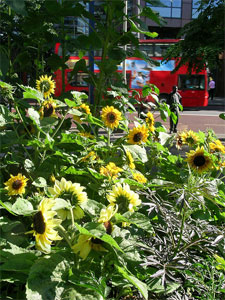
The Politics of Public Space
What is it about this style of gardening that makes it a "guerrilla" activity? Is there politics or revolution afoot? Is guerrilla gardening a modern day "love in", a "hippie objection to modernist filth" (as blogged by Kieran Bennett), or is it simply a mob of keen plant fans wanting to pretty the city? Well, to be honest, it's elements of all of these. Guerrilla gardeners generally work under the cover of darkness, organising "troop digs" and "actions" where keen guerrillas meet and transform an ordinary looking public (or private) space with trees, shrubs, annuals and more. They engage in on-going watering, maintenance and rubbish removal on planted sites, much of this also done under the cover of darkness. The general public are often encouraged, by signage located in the gardens, to water a guerrilla garden as they pass or collect rubbish if required. So, what's the big deal? A couple of people whacking in some plants... where's the harm in that?
Well, for one, it is illegal. Generally, the land that is being cultivated belongs to business, government or private parties, and, as we all know, mucking about with someone else's property is unlawful. The word trespass springs immediately to mind. Guerrilla Gardeners should, at all times, be mindful of this, and, unless troops obtain permission to use and cultivate the land, they could end up in real strife. That said, there have been many examples of Guerrilla Gardening actions that have targeted derelict, unused or unwanted land successfully, and without prosecution. Many of these have been areas like median strips, road verges, roundabouts, and neglected areas of public housing and utilities (think train stations and bus stops).
But, as extreme as it all may appear, there are certain "rules" Guerrilla Gardeners are encouraged to abide by... a code of ethics if you like. For one, all are encouraged to leave the land they target in better condition than when they found it. This means free of weeds and rubbish, with the soil having been improved (organically of course) and appropriate plantings in place (more on that later). The land should be unused when targeted, and likely to remain unused for the duration of the vegetations lifespan, and, most of all, the garden should look nice, and be fairly low maintenance.
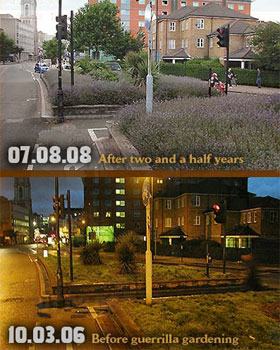
But does the garden have to be useful? Well, there are a few trains of thought on this, with many Guerrillas suggesting the improvement in aesthetics of drab and neglected urban spaces through reclaimed gardens is a useful public service. Other Guerrilla Groups are all about productive gardens; those that provide the gardeners and the general public with vegetables, herbs and fruit, and act to improve the 'feel' , 'vibe' and 'livability' of an urban space. Yup, it's a contentious issue, and one that pops up fairly frequently in Guerrilla Gardening discussions.
Weed Warriors
Okay, so I'll admit it, I'm intrigued by Guerrilla Gardening... in fact, I find it downright appealing! That said, I do have issues with the process, and here they are: I have enormous concern regarding the plant selections of Guerrilla Gardeners, both here and overseas. Sure, some of the groups are planting out edibles, but the bulk of them advocate the use of "low maintenance" "drought tolerant" plantings, those plants that will survive with a minimum of care and attention. Nothing wrong with that in theory, but I think a lack of horticultural knowledge and perhaps a limited understanding of broader global issues may see a significant number of these groups planting and spreading environmental weeds.
Consider this: 65% of invasive plants in Australia have originated from ornamental horticulture - that is, they have jumped from the backyard to the bush. Why have they been so successful? Well, many of them were sold as low maintenance, drought tolerant plants, those tough as boots garden varieties that even those with the brownest thumbs couldn't kill... exactly what many Guerrilla gardening groups look for in their suite of plants. So, while many of these groups may think they are doing the environment a favour, the may inadvertently be contributing to a whole world of weeds.
So, what would I do if I were a Guerrilla Gardener? I would mandate that all groups, cells, pods and digs of Guerrillas make their reclaimed spaces as useful as possible. By this, I mean plant suitable, non-invasive edibles, and kick start some serious urban food forests... your suburb will thank you! If edibles are not appropriate, what on earth is wrong with planting locally native plants? These are plants indigenous to the area, are uniquely suited to the climate, topography, soil and rainfall, enhance the character of the local area, and look fantastic. Hell, you may even create some habitat and support biodiversity along the way! All gardeners should be totally aware of all local, state and national invasive plant lists, and ensure that they are not adding to the issue.
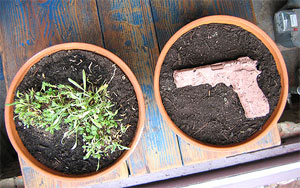
Sowing the Seeds of Dissent
Don't fancy skulking around under the cover of darkness, planting illegal gardens on public land but still want to make a difference? As Kurt Cobain once said "load up on guns, and bring your friends"... seed guns that is! Guerrilla Gardeners worldwide have been making and launching seed guns and bombs since the seventies, and, while they may all sound a bit violent, they are actually the complete opposite. Seed bombs and guns are made of a mixture of clay, organic compost, locally native plants seeds and a touch of water, shaped by hand and left to dry out and harden. These "weapons of mass re-vegetation" are then tossed, by hand, into neglected spaces, degraded public land, and hard to plant sites. Over time, a proportion of the seeds will germinate; bringing beauty and plants to what was once an eyesore. There are stacks of references on the web that will tell you how to make them... and I have to say, it looks like fun!
Guerrilla gardeners aren't just a mob of extremists, hardcore hippies and tie-dyed treehuggers, they are an intriguing mix of the young and the old, the plant savvy and the beginners, the 'out there' and the elderly... all gardening for a common purpose: to bring a little bit more beauty into the urban landscape! And I reckon... good on 'em!
Want to learn more? Check these links out:
www.abc.net.au/7.30/content/2008/s2354714.htm
www.laguerrillagardening.org
heavypetal.ca/archives/2007/03/how-to-make-seedballs
Photos
1 - A Productive tomatoe patch in an unused strip of suburbia - Melbourne - www.lastappetite.com
2 - A Guerrilla Garden smack in the middle of London, complete with sunflowers!
3 - A Guerrilla Garden, bringing life to the city, and looking top notch after two years!
4 - Shoots, roots and leaves....literally! A seed gun, the ultimate weapon in fighting urban ugliness! www.alrdesign.com
Life Without Lawn
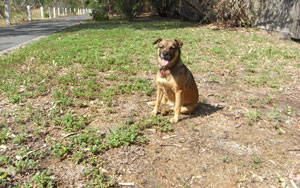
As a qualified horticulturist, soil scientist, and all-round know-it-all when it comes to plants, I am generally asked how to grow things, rather than how to kill them. But, of late, I have noticed a shift. My inbox is full of requests on how to kill an Aussie icon... the lawn. Now, normally I would be disturbed by green-thumbs turning brown, but not in this circumstance. Now, before you get on the blower and let me know that killing plants is wrong, let me explain.
The bulk of lawns, with a couple of excellent environmentally exquisite exceptions, are a monocultural monolith of foreign grass species. Contrary to popular belief, lawns are not low/no maintenance……in fact, most lawns require significant inputs (water, fertilizers, and herbicides, pesticides) to remain even vaguely appealing, not to mention the amount of time, effort and cold hard cash that can go into keeping turf tops! So, if you reckon it's time to ditch the pitch sustainably, read on.
Turf the Turf - Without Chemicals (of course)
Alright, so you've decided to remove the lawn, but don't know where to start. Well, firstly, don't reach for those chemicals. Yes, it may be quicker to spray and walk away, but think of the environmental impact of your actions. Heaps of herbicides can do hideous things to frogs, lizards, soil organisms and the soil itself, not to mention non-target plants, and, to be perfectly frank, you don't really need them in this circumstance.
So, what exactly do you need to set about removing your lawn? Firstly, you need patience... lawn removal doesn't happen overnight, but, I promise you, it will happen! Secondly, you need newspaper (or thickish cardboard), water, compost and mulch (I reckon straw based is the best). Thirdly, you need to check the weather. If it's windy outside, retreat to the shed (or the pub) and do something else for the day... newspaper + wind = very annoyed neighbours and a paper covered suburb (trust me, I share this from experience). Now, let's begin!
1. Grab your newspaper, remove any glossy magazines or inserts, wet it down, and cover the lawn area. The newspaper needs to be at least 15 pages thick, but, to be honest, the thicker the better. Essentially, you want the paper to break down nice and slowly over time. If using cardboard, remove any stray bits of packing tape and sticky tape, cut boxes flat, and lay this directly onto the area you wish to kill.
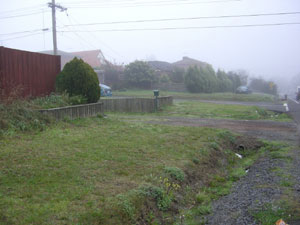
2. It is really important to make sure the edges of your newspaper/cardboard overlap. I reckon about 10cm is good, as this stops cheeky little weeds and persistent grasses peeking out between the gaps. Now it's time to cover the paper.
3. If the area is to be planted out in the future, but not immediately, I would suggest applying a nice 5cm layer (or more, if you have it) of compost, followed by a 7cm layer of mulch (go the straw mulch). Essentially, the finished area should look like a "trifle"... a few different layers of goodness to smother your lawn and improve your soil at the same time. But be warned that straw mulch can be blown off or even disturbed by the kids or family dog running across. So another 5cm layer of pine bark mulch on top would help solve this problem. And don't worry - there's no such thing as too many layers in this little exercise.
4. If the area is to be planted out immediately, your best bet is to import an appropriate growing media and compost blend (generally three parts soil to one part compost) and cover the paper with this, followed by a nice 7cm layer of straw based mulch. The depth of the soil will vary depending on what you are wanting to plant, but, as a rule, the deeper the better (look at about 20-30cm as a minimum). Avoid importing fill or topsoil, as this gear often comes from unsustainable sources and can be full of weed seed. If in doubt, ask your supplier for the origins of the soil. You can then plant straight into this area.
5. If you are converting the area into a space with no plantings whatsoever (eg: pathways, heavy traffic areas, open spaces) you have a couple of options. As the paper breaks down over time, you may wish to consider an alternative base layer. Now, before you rush out and buy metres of plastic, consider the long term impact of this on soil health. Plastics are not porous, so neither water nor air can reach the soil beneath. This in turn will kill every living creature and micro-organism within the soil and degrade the soil itself. It can also lead to significant issues regarding run-off and ponding of water after irrigations events or rain. A safer option is woven fabric weed matting, which allows for air and water movement, or jute/hessian matting, especially handy if working on steep slopes. Once this has been laid, cover the area with appropriate mulch.
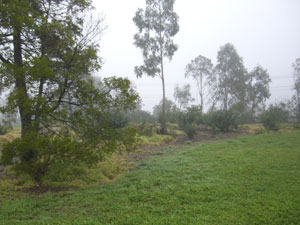
Trouble shooting...
Alright, this is all good and well in theory, but there are a few niggling questions that need addressing. So here they be:
What's the story with the inks in the newspapers... surely that can't be good for the soil?
Well, according to the Publishers National Environment Bureau, the inks used to print newspapers and magazines in Australia are completely safe. Black and colour inks have no added heavy metals and contain either vegetable oils produced from crops like soya beans and canola, or non-hazardous mineral oils of very high purity. Most inks actually use a mixture of these two types of oil. Oils comprise about 50% of newspaper ink - the rest is made up of pigment, resins and solvents. In the grand scheme of things, it's pretty safe... just remember to avoid the glossy and heavily coloured stuff.
Can't I just use newspaper on its own?
Short answer... no! Newspaper can act as a bit of a wick, and acts to draw water out of the soil rather than keep it in. The most successful way to smother lawns and weeds while improving the soil is to add as much organic matter over the paper/cardboard as possible. It will encourage the worms, and, by the time it has all broken down, you should have a magic, grass free soil, ready to be planted.
What about solarisation?
Solarisation is the process whereby grass, weeds and the like are effectively "cooked" under a sheet of plastic. Solarisation is an excellent way of killing grasses and weeds that have significant soil seed banks, but has the potential to go a bit pear shaped. For starters, there is a bit of discussion regarding the best type of plastic for effective solarisation. Most studies conducted have shown that clear plastic works best, but there are a few pre-conditions.
Firstly, the plants have to be actively growing, so it is important to identify the grass species, and do a bit of research as to its active growing period.
Secondly, solarisation can take upwards of four weeks (of pretty consistent sunlight and fairly decent temperatures), so this is not a quick process.
When laying the plastic, try to minimize the amount of air between the soil and the plastic. You can do this by burying the edges of the plastic, and weighting it down. This increases the heat generated between the plastic and the soil, and will be far more effective.
Now, while solarisation may have its benefits, it also has some problems as well. While it is a great way to kill off any weed seed and nasty pathogens in the soil, the impact of solarisation on soil health and biotic activity is not fantastic, so organic matter should be added at the end of the solarisation period to help "Kick-start" your soil again.
Oh, and for goodness sake, when you remove the plastic, apply mulch or a green manure crop ASAP! This will prevent a recolonisation of grasses and weeds cause, as we all know, grasses and weeds are mad for bare soil.
As far as I am concerned, less lawn to grow is less lawn to mow, but I know this isn't always a popular opinion. But if, like me, you want to convert lawn space to productive space, this guide should do the trick.
Scale
Hi, my name is: Scale
Describe yourself: I'm tiny (about 2mm) but that's not a problem as I'm really unattractive. I am a single mum with up to 2000 kids, but don't let that put you off! I have a nice hump... a small round shell I guess you would call it. It can be hard or soft, waxy or armoured and comes in white, brown or black. It gets darker the older I get. I'm shy so I live permanently under my hump. I am easily overlooked, and sometimes people think I am just part of the plant!
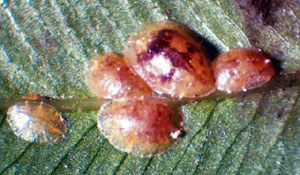 Hobbies: Hanging out along the stems and veins of leaves and sucking sap. I sometimes lay eggs and then sit really, really still and watch my thousands of babies wreak havoc! If I am a soft scale, I just love exuding honeydew!
Hobbies: Hanging out along the stems and veins of leaves and sucking sap. I sometimes lay eggs and then sit really, really still and watch my thousands of babies wreak havoc! If I am a soft scale, I just love exuding honeydew!
Likes: I adore citrus and most woody plants, but I am also partial to succulents and vines. I don't mind gardenias, holly, many house plants, hibiscus, apples, pears and plums. I have a really great relationship with ants and they really look after me.
Dislikes: Predatory mites, green and brown lacewings, predatory thrips, spiders, small birds and parasitic wasps. I despise home made vegie oil soap mixes or store bought alternatives.
You'll know you've met me when: Your leaves start turning yellow and dropping off or you can see me and my girlfriends all over your trunk! If I exude honeydew, black sooty mould may turn up. Then your tree looks like it's covered in charcoal!
Breaking up ain't hard to do... if:
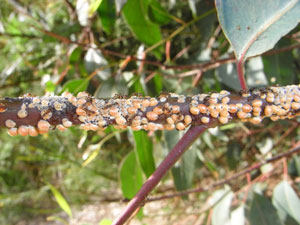
- Encourage predatory mites... this is pretty easy, especially if you use compost, manures and mulch your soil! They love this stuff.
- Buy some predatory bugs
- Give me a blast with a high pressure hose in the morning, three days in a row.
- Get out the vacuum, and suck me off the plant... yep, some people actually do this!
- Use home made veggie oil soap mixes or store bought alternatives
- Tell my friends to stop coming around! Ants look after scale, so spreading tansy around the garden will stop the ants, and seriously reduce the scale around!
- Pay your neighbours' kids to come round and wipe us off with a stick!
- Dab us with rubbing alcohol... man, that burns (but it won't harm your plants)
Photographs:
Pic 1: http://mrec.ifas.ufl.edu/LSO/scales.htm Desc: The delightful brown soft scale
Pic 2: Elaine Shallue, SGA Desc: Gum Tree Scale with ant friends!
Pesticide Use
Ontario says NO to Pesticides
Ahhh pesticides, a controversial subject at the best of times. Over beers with mates (bearing in mind we are ALL plant dorks) the use (and mis-use) of pesticides is a common topic, one fraught with danger and fought with vigour. So, why all the controversy? Surely we can have a quiet beer and a civilized chat about pesticides and all agree on the pros and cons? Well, we don't, and a lot of it comes down to the nitty gritty of what a pesticide actually is.
What defines a pesticide? Technically (and I do love to get technical) a pesticide is a substance or mixture of substances used to kill a plant or animal pest. So, this includes herbicides, fungicides, insecticides, miticides and the myriad of other "icides" that greet us in giant hardware stores or granddad's back shed. Yeah, I know, I was shocked at the definition too!
SGA takes the point of view that integrated pest management is the best approach in the garden, only resorting to low environmental impact pesticides as alternatives when all else fails.
My gut feeling has always been that we can manage without pesticides, or at the very least choose a low environmental impact alternative, a viewpoint that causes mixed responses from my mates at the sticky round table. Mate One, a residential garden maintenance contractor claims he wouldn't get paid without the use of pesticides. I mean, who is going to pay a maintenance man when the job isn't top notch - broadleaf weeds and nasty creepy crawlies in palatial backyards do not a happy employer make!
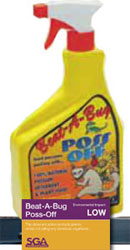
Mate Two, from a crop farming background, reckons he would seriously struggle to maintain viable cropping country without the use of pesticides. All manner of exotic plant and animal species would threaten his livelihood.
Now consider Mate Three, who I refer to as a "Caped Conservation Crusader"! Any greener, and she'd be completely camouflaged in the beautiful bushland where she works. But even she uses pesticides on a daily basis, to fight insidious and ever advancing invasions of weedy plant species that threaten our precious bushland!
But what prompted our most vigorous debate of late was the discussion regarding Ontario province in Canada's ban on the sale and general use of pesticides in residential / domestic settings. The exclusions include golf courses, farms and forests. This legislation was introduced after intensive lobbying from environmental activists and health professionals.

"Great", I announced, "finally a government displaying serious environmental leadership". Who would have thought this decision and subsequent comment would have led to so much discussion?
For one, the lawnmower man uses chemicals in residential landscapes. If he lived in Ontario he would no longer be able to do so. The problem is that not all pesticides are created equal, so even though he may use low environmental impact products he would still be breaking the law. What about bug sprays? They are technically pesticides. What about home made chilli sprays and the like? They are also classified as pesticides... the mind boggles!
My farmer mate reckons that while people may be a bit nervous about the misuse of pesticides, there would be even more concern if we didn't use them, especially in an agricultural sense. He claims (and I looked it up so it is true) that without pesticides Australia would lose $7000 million per year because there is nothing to combat hideous farming problems like invasive plants, locusts and sheep blowfly!
Then we had some input from the Caped Conservation Crusader, who suggested that pests (of all sorts) are an ecological problem, and therefore require an ecologically sustainable solution. Without the daily use of herbicides, Caped Crusader's areas of remnant vegetation would be lost forever under a mountain of weeds... mostly garden escapees! Amazingly, she is opposed to the ban in Ontario, suggesting that the use of backyard herbicides may prevent the problem of invasive plants hopping back fences! I was surprised, but impressed at the same time (it may have been the third beer or my utter shock at my green mate calling for herbicide use in backyards).
Another round of beer, and the following was decided. We like, and dislike pesticides... and here's why:
Arguments for using pesticides:
- Cost effectiveness - pesticides are an economical way of controlling issues, especially the large-scale stuff.
- Timeliness and flexibility - by selecting the best product for the situation, pests can be managed quickly and effectively, saving a great deal more chemical application in the future.
- Prevention of problems - preventing weeds in gardens, lawns and large scale landscapes, preventing the spread of pests.
- Protection of pets and humans. Without chemicals the treatment of spiders, cockroaches, and fleas would be tricky.
- Protection of the environment. If no chemicals were available to control environmental pests like noxious weeds, feral animals etc., our environment would suffer very badly. Using herbicides to control crop weeds reduces the need for cultivation, thus reducing land degradation.
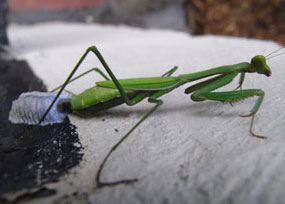
Why we don't like pesticides:
- Reduction of beneficial species. Non-target organisms, including predators and parasites of pests, can also be affected by pesticides. This results in changes to natural systems and biological balances. Think of the bees, won't someone think of the bees!!
- Drift of sprays and vapour during application is just plain bad, and can cause untold damage in the general environment.
- Environmental pollution from careless application and runoff can result in wildlife and fish losses.
- Ground water contamination by leached chemicals can occur in high use areas if persistent products are used.
- Resistance to the pesticide used can develop in target pests due to overuse and/or incorrect use of the chemical.
- Poisoning hazards and other health issues to operators can occur through excessive exposure if safe handling procedures are not followed and protective clothing not worn.
- Other possible health effects due to indiscriminate use of chemicals can be a serious concern.
So after vigorous debate, and a few more rounds of beer, we came to the following conclusions. One, we all need to get out a bit more (or at least find something else to talk about). Secondly, pesticide use in any setting needs to be seriously assessed before wanton application occurs. We came up with the following list of behaviours that we all need to undertake before and while using pesticides. These apply across the board, whether the application be horticultural, residential, agricultural or ecological.
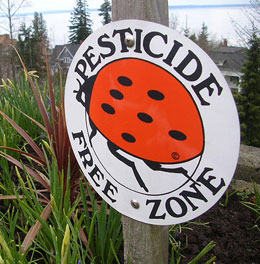
- Consider safe, non-chemical alternatives to pest control, including hand-weeding, mulching, biological controls, cultivation, garden bed rotation, mowing and slashing, growing pest repellent plants and so on.
- Choose a low environmental impact pesticide (SGA 6 star rated).
- Read and understand the label, taking special note of the rate of application and the safety directions.
- Make sure the chemical is designed to control the pest you are using it against.
- Always prepare and apply the chemical according to the manufacturer's instructions given on the label.
- Do not spray under adverse weather conditions, e.g. on windy days (to avoid off-target damage).
- Be particularly careful when using chemicals near waterways or stormwater drains.
- Take appropriate personal safety precautions.
Now, don't get me wrong, I am not suggesting all pesticides are evil, nor I am standing on my happy little soapbox singing the praises of chemical control. What I reckon though is that they do have their place, and, while my mates and I agree to disagree on a number of pesticide related issues, there is one thing we are all united on: If they must be used, choose a pesticide from the 6 star range listed on https://www.sgaonline.org.au/pesticide-use/
Root Knot Nematode
Hi, my name is: Root Knot Nematode
Describe yourself: For some reason, heaps of people are really scared of me. I don't know why, I'm just a microscopic little critter who looks a bit like an eel. I'm not a bad guy, it's just I have this toxic saliva that seems to destroy everything it touches...
Hobbies: I love roots! Roots are my life! I adore entering roots and nibbling the goodness out of them, while secreting my terrible saliva. Apparently this causes rotting, abnormal cell enlargement and multiplication (like galls), abnormal cell division that results in an excessive number of lateral roots, and general stunting.
Likes: Roots, especially those of tomatoes, potatoes, beans, carrots, wheat, grapevines, and ornamentals such as many cut flower varieties. I especially love sandy soils, it lets me breathe and move about! I love warm weather and curling up with an egg sac over winter!
Dislikes: The roots of a few plants (French Marigold and Asparagus mainly) confuse my lifecycle and can result in my untimely passing, resistant plant varieties, crop rotation, regular watering, compost and mulch.
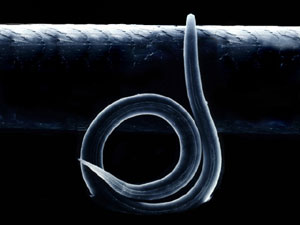
You'll know you've met me when: Well, this is part of the problem, you probably won't know until you pull out your plants and have a look at the roots. Because I hang out underground, the first you may know about it is slow growing, stunted plants with pale green or yellow leaves
Breaking up ain't hard to do... if you
-
- Forget about the chemicals... this ain't going to work for us little fellas!!
- Destroy all infected plants by bagging and disposing in rubbish, or burning. Do not compost.
- Rotate your crops!!! Don't plant the same crops, or susceptible crops in the same area each season. And the crops that replace them must be immune to the nematode or have a high level of resistance. These include some grasses, cabbage, cauliflower, sweet corn and onions.
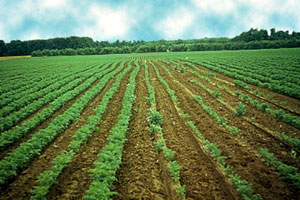
- Plant loads of French marigolds in your patch with susceptible plants! French marigold roots produce exudates that stimulate hatching of nematode eggs, but when the larvae enter these plants they die without completing their lifecycle.
- Try a little asparagus! Asparagus roots secrete an exudate that is toxic to nematodes.
- Regularly water, use compost and mulch, and keep the soil rich in organic matter!
Photographs:
Banner image: CSIRO, CC BY 3.0, https://commons.wikimedia.org/w/index.php?curid=35486044
Pic 1: http://www.avrdc.org/photos/tomato_diseases/index.html
Pic 2: http://www.nematology.umd.edu/rootknot.html Desc: Here I am... what a handsome devil!
Pic 3: http://www.apsnet.org/Education/LessonsPlantPath/RootKnotNema/default.htm Desc: A carrot crop showing Root Knot Nematode Damage
Composting How-To
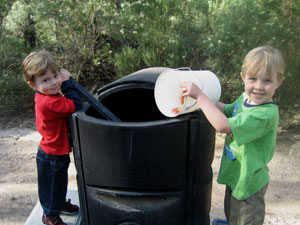
Firstly... what is compost? Essentially, compost is a mixture of decaying organic matter, generally comprised of leaves, cuttings, kitchen scraps and manures. Now, people do put strange things in their compost, and do odd things with the finished product, but hopefully, by the end of this article, we will all be on the same page!
Compost excites me greatly, much to the horror of my nearest and dearest! There is a whole little world happening inside my compost heap - life, death, decomposition, heat, relationships... amazing, and much more interesting than my own existence. Thing is, I know it's happening, but I can't necessarily see it. I do see the results though, when my forgotten Iceberg lettuce and Sunday papers end up as beautiful, rich, crumbly compost (after a number of weeks).
What's the point to all this?
Apart from allowing me to live a fascinating life vicariously through the microbes in my heap, compost is surely the greatest garden invention of all time (heaps better than those giant plastic rake hands, cheap tools and robot lawn mowers!). Why? Because it improves my soil, and the state of the planet.
All soil types benefit from the addition of compost, as the presence of organic material in the soil introduces microbes (little microscopic critters who are essential to a healthy soil), that break down the compost. In turn, this brings worms into the soil to feed on the microbes. And as we all know, worms are the gardener's best friend! They are so industrious that in a short period of time their activity can greatly improve any soil type... go the worms!!!!
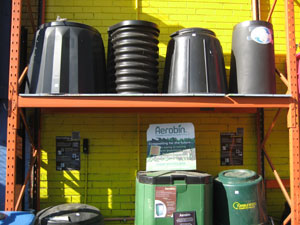
The water retention in light, sandy soil can be greatly increased by the addition of organic materials, and this in turn creates an ideal environment in which the worms will thrive. As the compost breaks down, nutrients are released into the soil, also creating a food source for your plants. So this simple process dramatically improves light soil in two very important ways, providing a long-term remedy to these problems. So, before you nip out and spend heaps of hard earned cash on water crystals, try compost first! It's way better for the planet, the soil, and your back pocket!
Even heavy clay can be greatly improved by the addition of compost. Don't break your back trying to dig up heavy clay! Just add a generous layer of compost on top of the soil, cover with lots of lucerne, pea straw, or fine mulch, and then go to the fridge, grab a beer and relax! Your hard work is done for a while, apart from the occasional watering during hot weather, other wise leave it to the rain to keep the area moist. After a few months you will find an enormous amount of worm activity has taken place, which will have broken up the clay, improved the texture of the soil, and subsequently improved the drainage too. To really improve the structure of clay soils, use fairly fresh compost.
Much Ado About Poo
Other materials that can be incorporated into the composting process include animal manures (by which I mean cow, sheep and chook, not Fido and Kitty's poo!), which will introduce valuable microbes into your compost 'micro climate'. It's a really good idea to use these in your compost recipe, so that by the time you apply the compost to your garden the manure is well rotted. Fresh manure should never be applied directly around plants, as it will burn the roots and severely stress your plants.
One very important thing to remember is to avoid obtaining horse manure from racing stables, because if the horses have been treated with antibiotics and worming treatments then the manure will not contain the desirable microbes needed for healthy composting. This can even result in the subsequent death of your plants as there are no 'good' microbes in the soil!! Make a point of getting your aged manures from only natural, organic sources.
Okay, word of warning with this paragraph... if you're enjoying your morning cuppa and a chockie biscuit, skip this bit and come back to it later. I'm about to broach a sensitive subject, but one I receive a lot of inquiries about... humanure! All I'm going to say is this... don't put it in your compost heap! I love composting toilets (such as the Rota-Loo) and reckon it should be mandatory to install them in new homes, but the composting of human excrement at home (away from the amazingly awesome composting toilets) is fraught with danger, and not something I would recommend. Unless People Poo is composted at really high temperatures over a long period of time (at least 9 months) there is a significant risk of disease and just plain old ickiness. So don't say I didn't warn you!
I've got worms!
Worm farms are also an excellent idea, offering a convenient alternative to compost bins if you don't have much space in your garden. This is another way to provide your garden with important nutrients and organic materials, and a very easy way to ensure you have plenty of worm activity to help improve your soil quality. Check out our worms page for more info.
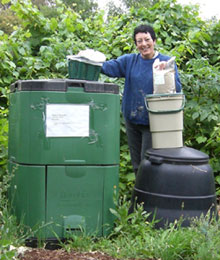
One Bin to Rule Them All
I often get asked which is the best type of composting bin or structure, and my answer is always the same. Unfortunately, I am reluctant to print it here because I don't want to run the risk of being sued (I do this job for the love, not the money!), and therefore will just say this: using an expensive, high energy, plastic based container for composting doesn't seem to be that sustainable to me in the long run. If the look of a steaming pile of compost in your backyard doesn't float your boat, store bought systems are better than nothing. I mean, at least you're composting. But think carefully about the "cradle to grave" lifecycle of your bin, and, if you must go plastic, have a look for a bin made from 100% recycled plastic. They are out there; you just have to find them.
Nature Strip and Road Verge Plantings
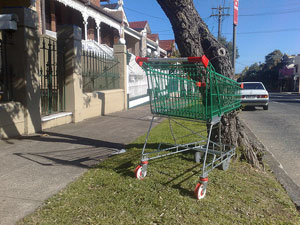
Funny thing about houses (and I should know, I've lived in quite a few) is that in every single one there is an area (or areas) that could best be described as "a waste of space". Weird corners that no side table can fit into, funny skinny hallways unsuitable for anything other than skating in socks and racing the kittens, unusable alcoves under stairs, and the ubiquitous corner cupboard by the oven in the kitchen that inevitably becomes a black hole for Tupperware and baking trays.
But, the greatest waste of space of all is generally located outside the house. It's the nature strip, and I reckon it's time we all paid some attention to this oft neglected but all too visible patch of nothingness!
Real Turf / Fake Turf / No Turf
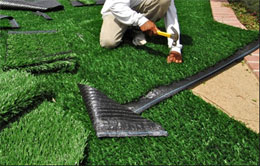
It's time to talk turf... we've had a bit of rain, the soil is warming up, and loads of people are starting to think about sowing seed, rolling out grass, and spending the rest of their spare time mowing and maintaining their great green sea!
Over the last couple of years there has been a significant shift in the lawn and order of grass, both here in Australia and overseas. Homeowners are seriously shifting from turf to fake grass! That's right... fake grass (or synthetic turf as the manufacturers prefer you to call it)! Let me just point out right now that the fake turf we all grew up mocking and loathing has come an incredibly long way and actually looks pretty darn good these days.
So, what’s the story? Is fake grass better than real grass for the environment? Some very well known and well respected gardeners say “Yes”, while others disagree. So, to further explore these turf wars, a not so well known and occasionally respected gardener has done a bit of research, watched the grass grow, and presents you with the good, bad, and everything in between regarding real vs. fake.

Revealing the Real Stuff
The concept of the lawn originated in England, in the late 1600's to early 1700's, and was regarded as a "status symbol", due to the extremely labour intensive processes involved in the maintenance of a nicely clipped lawn (remember, this was well before the invention of mowing machines in the 1830's). Huge areas of lawn were developed for recreation, play, and as a "green sea", effectively creating a cooling affect in many landscapes. As European settlers made their homes in Australia, they bought many of their English style gardening practices with them, including the good old lawn.
This created some significant problems. Firstly, maintenance of a lush green lawn in Australia required massive amounts of water. You see, in temperate England, where lawn originated, the annual rainfall was more than sufficient to support and maintain healthy lawns. In an aridity prone continent like Australia, just keeping lawns alive required larger, often environmentally invasive water supply systems. The other issue facing our first turf masters was the usage of exotic grasses in a harsh and unforgiving climate. Some of these species failed, but some (such as kikuyu) flourished, to the point they are now considered weedy.
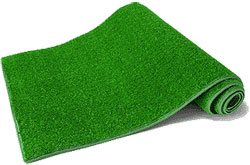
Faking It
Unlike the real stuff, fake grass was developed in the 1950's, with the patent for Astro Turf, the original fake grass awarded to Monsanto in 1967. Astro Turf was originally designed as a sports field surface, but, as any older hockey player will remember, this surface was hard, scratchy, and did more harm than good (especially to players ankles, knees and ACL's). But, like all things, there has been a revolution, and the current synthetic turfs are incredibly realistic, look fantastic and feel great underfoot.
So, fake grass must be green? Sure, synthetic turf installations use less water than a traditional lawn, they don't require pest and disease management (therefore reducing harmful chemical inputs) and they don't need mowing (saving time, money and emissions). But don't get too eco-excited just yet! Synthetic turfs are a petro-chemical product, meaning they are pumping out the black balloons at time of manufacture. Modern synthetic turf, especially when used as a playing surface, is in-filled with rubber granules made from recycled tyres (seems sustainable….but is it?) as this helps reduce joint injury during play. American research has shown us that these tyres have the ability to release a whole host of "volatile organic hydrocarbons" (fairly bad stuff), as well as other toxic chemicals. While obviously being fairly bad for human health, consider the long term impact of these products leaching into soil and groundwater! Horrifying!
Turf Wars - Comparing the Two
Okay, so what we really want to know is…which one is better for the environment? Loads of eco-aware homeowners are being told that fake is the new green, while traditionalists feel that real is the eco deal. Both products have their advantages and disadvantages (environmental, social, financial and otherwise), and, to be honest, I am loathe to recommend one over the other in terms of sustainability and environmental impact. Instead I will leave it to you, dear reader, to make up your own mind.
Fake Turf - Advantages
- It's always green (unless of course you buy a cheap and nasty version that fades….don't laugh, I've seen it!).
- Less chemical and physical inputs over time (remember low maintenance doesn't mean NO maintenance). This is an extremely appealing environmental outcome.
- Low water requirements (again, low doesn't mean no). Many synthetic turf manufacturers recommend applying water to the surface, to prevent soil underneath from cracking, and to cool the surface.
- Suitable for "difficult" installations (e.g.: low to no soil, pool surrounds, rooftop areas, low to no natural light etc.)
- Good quality synthetic turf should last a minimum of ten years, with some lasting up to 35!
- Good quality synthetic turf may actually save you money over its lifespan…..so while installation is expensive, you are saving on pesticides, herbicides, mowers, brush cutters and their petrol (not to mention getting your weekends back!).
- Can be incredibly aesthetically pleasing, and allows greater design and installation flexibility than real turf.
- Excellent "dust prevention"... a covered surface is always better than a dust bowl
Fake Turf - Disadvantages
-
- Depending on the installation process, the rubber bedding they use as infill can contain heavy metals and VOC's, which is nightmare stuff for soil and groundwater health.
- It is recommended that all soil be heavily compacted before installing synthetic turf. Goodbye soil structure, soil microbes and soil life... and good luck to any tree roots in the vicinity!
- The porosity and permeability of some synthetic turf is fairly woeful... again not allowing a lot of moisture through to the soil.
- Being a petrochemical product, the manufacturing process is less than ideal for the environment.
- Fake turf does nothing to capture atmospheric carbon….in fact there was an American study that suggested it may be contributing to it, due to the high amount of heat fake turf gives off.
- It needs to be cleaned... with disinfectant! Why won't anyone consider the soil?
- It does nothing to enhance backyard bio-diversity
- It has been associated with high incidence of sports injury, especially strain type injury and a phenomenon known as "turf toe" to it's lack of give
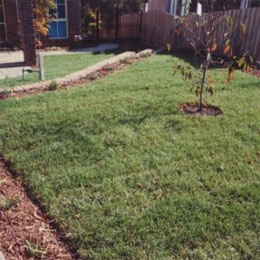
- It's darned expensive!
- What happens to it when it has passed it useful life... it ain't designed to break down quickly, meaning a long stay in landfill!
Real Turf - Advantages
- Real grass sequesters carbon... hooray!! Australian lawns and playing fields can absorb a massive amount of CO2 every year... what a top carbon sink!
- Real turf produces oxygen... 58 square metres of lawn provide enough oxygen for one person for an entire day.
- Lawns modify temperature around buildings, and in our urban spaces. On a block of eight average houses, front lawns have the cooling effect of 70 tonnes of air conditioning.
- Excellent "dust prevention"... a covered surface is always better than a dust bowl
- Real turf can trap an estimated 12 million tons of dust and dirt released annually into the atmosphere.
- Houses surrounded by turf are less likely to be affected by bushfire, as the turf retards the spread of fire.
- Real turf reduces run-off, helping to filter the water before it recharges the groundwater
- It's attractive... well, it can be.. and kids and pets are more likely to roll about on a patch of real lawn.
- Healthy grass provides a feeding ground for birds, who find it a rich source of insects, worms, and other food.
- Unlike fake grass, real grass does not have a negative impact on soil health.
- Lawns can actually survive on very little water
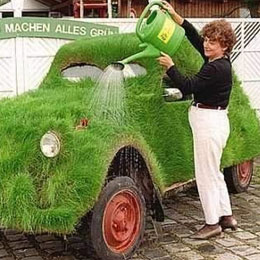
Real Turf - Disdvantages
- Most lawns are composed of a single species of plant, creating a monoculture which significantly reduces biodiversity, especially if the lawn covers a large area.
- Monocultures lead to an increase in pest and disease issues, requiring the use of pesticides and herbicides, many of these having significant negative environmental impacts.
- Many people overwater their lawns, believing they need a lot of water. This leads to shallow rooting grass, which dries out rapidly in summer, prompting people to dump more water on their lawn. Overwatering also leads to significant fungal problems and pest issues, encouraging the use of horticultural chemicals.
- Water restrictions prevent us from watering turf at all….this is not a good scenario for an introduced grass species.
- Most of our lawns are composed of turf species not local to our area (or even our country), further decreasing local biodiversity, and adding to weed problems in our remnant bushland (I'm looking at you Kikuyu)
- The greening of turf in our urban spaces generally requires considerable use of fertilisers which, as we know, have contributed to the degradation of much of our countries soil and water catchments (think algal blooms in our precious waterways). Studies have shown that up to 60% of synthetic, nitrogen based fertiliser applied to lawns ends up in our waterways!
- An American study found that over 3 million tons of synthetic lawn fertiliser was dumped on lawns in the US of A. While it won't be this high in Australia, its still heaps!
- Mowing is a pain, for you and the environment. One hour of mowing is the pollution equivalent of driving a car for 150km. Mower noise is offensive, and mowing is time consuming. On the flip side, it's good exercise!
- Pesticide and fertiliser use is significant, and can have some seriously negative environmental impacts further down the line.
There are many more environmentally sound, lower maintenance options available than the traditional lawn or the synthetic stuff. Please consider some of these 'greener' alternatives when planning your open space. Not only will you be helping the environment, you will have more time to kick back in your banana lounge and read a good book. Click here to find out all about lawn alternatives... the sustainable solution!
References
1. Lawton, Graham (04 June 2005). "Pitch battle over artificial grass". New Scientist (2502): p.35.
2. Forbes. Retrieved on 2008-01-11.
3. New England Journal of Medicine article
4. David R. Brown, Sc.D. (2007). "Artificial Turf" Environment & Human Health, Inc.
5. C. Frank Williams, Gilbert E. Pulley (2002). "Synthetic Surface Heat Studies" Brigham Young University. Retrieved on 2008-02-19.
Weevils
Hi, my name is:
Weevil
Describe yourself: At just about any stage of my life cycle, I freely admit to being no super model. I am most easily distinguished by my large “snout”, a protrusion at the front of my head not shared by other bugs. We can vary in size from 7mm to 12mm and depending on our species, we can be a range of colours. My gorgeous larvae are also easily identified through their distinct brown heads and legless, light brown to white bodies.
Hobbies: As a youngster I love spending my time under the soil munching away on your plant roots! But, as I mature my tastes change and I adore hanging out on the green stems and leaves of plants, scalloping their foliage and making a real mess. Oh, and my mate, the black vine weevil hangs out under bark, feeding and ringbarking your plants!
Likes: Ornamental plants but especially vegetable crops. I love beetroot, carrot, potato strawberry, cabbage, broccoli and lettuce. Larvae of the fruit tree weevil will happily munch the roots of a range of fruit trees including pears, citrus, apples, figs and apricots. The black vine weevil enjoys a range of vines....as the name suggests, and has a real taste for olive trees.
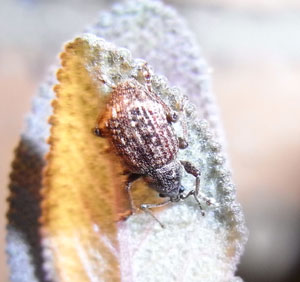
Dislikes: Hygienic gardens, crop rotation, plants that are healthy, happy and not stressed.
You'll know you've met me when: Young plants can be ringbarked, roots munched away and the foliage scalloped. You can often see me as an adult moving up the stems and trunks of plants after pupating in the soil.
Old School Control Methods: Hideous chemicals applied in the afternoon to knock out night-crawling weevils. Nasty!
If you want to dump me, you could try to:
-
- We weevils are difficult to eradicate from a garden bed but crop rotation is a useful tool. If vegetable weevils are present plant peas and beans as your winter crop to starve us out. Avoid planting root vegetables such as carrots and beetroot if you really dislike us.
- Ensure susceptible plants brought into the garden do not contain weevil larvae and, should you be giving plants away, be just as cautious about passing us to your friends.
- A once-off forking over of garden beds when larvae are present may help to eradicate us.
- Place pieces of plastic sheeting around the base of infested trees and shake. The weevils will fall from the tree and can then be collected in a bucket and drowned.
- Introduce some chooks, ducks, or even guinea fowl to the patch. These guys will make short work of weevils.
- “Band” susceptible trees with greasy hessian sacks, aluminum foil or horticultural glue. This traps us adult weevils on our way up the tree, and interrupts our breeding cycle.
- Ensure plants are not water stressed, as this makes them more attractive to us weevils.
Red Spider Mite
Hi, my name is:
Two-spotted Mite (or Red Spider mite to my friends)
 Describe yourself: Well, my closest relations are spiders, but don't let that put you off! I'm TINY (about .5mm), greenish-yellow and look good in spots (two big black ones on my back). I change things a little in autumn when I look good in red - in line with the season.
Describe yourself: Well, my closest relations are spiders, but don't let that put you off! I'm TINY (about .5mm), greenish-yellow and look good in spots (two big black ones on my back). I change things a little in autumn when I look good in red - in line with the season.
Hobbies: Man, I suck... and suck, and suck! I enjoy spinning webs, and hanging out on the underside of leaves in a big group.
Likes: Heaps of fruit trees (I go crazy for apple and peach trees), veggies (especially cucumbers, capsicums, tomatoes and beans), and I adore roses, berries, azaleas and marigolds. Hot, dry weather, with low humidity really gets me laying eggs! And violet patches are a good spot for taking my winter break.
Dislikes: Predatory mites, green and brown lacewings, predatory thrips, spiders and parasitic wasps. I despise home made veggie oil soap mixes or store bought alternatives.
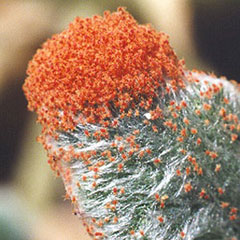 You'll know you've met me when: Your leaves look mottled or bronze - especially on the top. If I have been around for a while, and breeding up a storm, the leaves might even fall off! If you look underneath the leaves, it's a bit of a mess - we're an untidy bunch! Have a look for my webs, so you don't confuse me with thrips!
You'll know you've met me when: Your leaves look mottled or bronze - especially on the top. If I have been around for a while, and breeding up a storm, the leaves might even fall off! If you look underneath the leaves, it's a bit of a mess - we're an untidy bunch! Have a look for my webs, so you don't confuse me with thrips!
Breaking up ain't hard to do... if:
- Evict me with predatory mites... they're easy to attract, especially if you use compost, manures or mulch your soil! They love this stuff.
- Drench me with a forceful jet of water in the early morning for 3 consecutive days.
- Suck me off the leaves - using a vacuum on low suction. Yep, some people actually do this!
- Spray me with a home made garlic or chilli soap. Or use a store bought insecticidal soap and target the undersides of the affected plant leaves where I usually like to shelter.
 Photographs:
Photographs:
Pic 1: www.mumsanddahlias.com
Pic 2: www.thewaterwisegarden.com
Pic 3: www.ces.ncsu.edu Desc: Typical Mite damage on foliage
Healthy Soil - Boring But Important
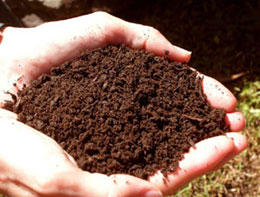
Soil... most people just think of it as dirt, something to grow a few plants in, and maybe something to play in when you are young. Now, before you nod off or skip to a more exciting article, consider this: "Would you dig a hole in your backyard, throw in your wallet, cover it up and walk away?" If the answer is no... read on. If the answer is yes, I have several holes at my place I have prepared earlier!
Some people reckon soil is boring, and that it may be, but it's darned important! Healthy soil is a living, breathing organism, vital for the health and well-being of our precious plants out in the garden. And just as we feed and nurture our plants, so must we feed and nurture our soils. But what determines a healthy soil, how do we achieve it, and how will it benefit us, as gardeners? This is the first in a series of articles on soil, so brace yourself for the thrilling world under our feet!
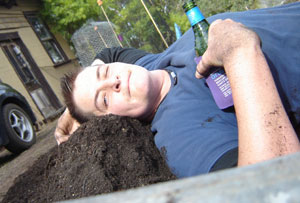
What is a healthy soil?
Firstly, lets' talk about what soil actually is. Technically, it is the thin layer of material that covers the earth's crust. It provides plants with support, mineral nutrients, water and air. Soil is derived from the weathering and breaking down of parent material (rocks), with the addition of varying types and levels of organic matter. The amount and type of organic matter in the soil, coupled with the original parent material, determines the structure, nutrient content and behaviour of the soil. All very important factors to understand when planting out a garden.
Most Australian gardeners are presented with quite poor soils. These are a result of housing and urban development, overworking, previous chemical practices, poor watering practices and so on. In addition, much of the soil in our urban and suburban spaces has been bought in from elsewhere, relocated as it were, with gardeners facing a bit of an unknown quantity when they venture out the backdoor.
But, as we know, the most important factor in a healthy garden is healthy soil. This basically means that your plants can only be as good as the soil they grow in. If you have an exhausted soil with no nutrients your plants will struggle, and may starve to death.
If you have light sandy soil, your plants may not get enough moisture and will probably die of thirst.

If you have heavy clay soil, your plants will not get enough drainage and will probably drown!
Soil is full of life and it needs some of the same things which animals and plants need to survive, like air, water and nutrients. We can not easily see all the activity going on in the soil but we can smell it and feel it to get a sense of its health.
Healthy soil smells sweet. It's loose, well drained and rich in organic matter. Air and water move freely through the soil because air space exists around soil.
Healthy soil will have about:
- 24% air
- 25% water
- 45% minerals
- 3-5% humus
- up to 1% living organisms
(Humus is the dark organic material that is the end product of composting).
But what if your soil is not healthy and your plants are not performing? Fear not, we have the answer!
How can I make my soil healthier?
To have lovely healthy plants, you need healthy soil... and to have healthy soil you need the following important ingredients:
- Compost
- Moisture
- Mulch
- Good drainage




